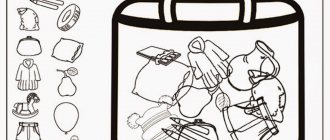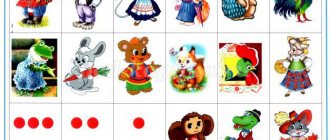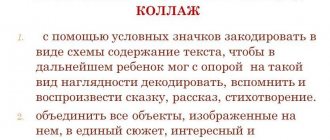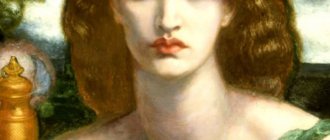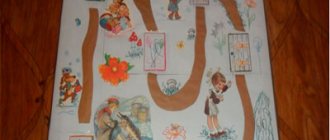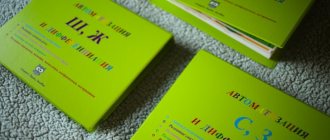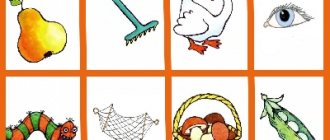Mnemonic table based on the fairy tale “The Snow Maiden”
Diana Aitmukhametova
Mnemonic table based on the fairy tale “The Snow Maiden”
What are mnemonics and mnemonic tables .
What are the benefits of mnemonic tables for children .
At what age can you practice mnemonics ?
What you need for classes.
How to study using tables.
Select Mnemotable .
I want to tell you about one of my favorite techniques for developing memory and speech - mnemonics . In more detail, I would like to dwell on the consideration of mnemonic tables for children . And introduce you to the use of this interesting method.
What are mnemonics and mnemonic tables .
Mnemonics is a system of various techniques and methods aimed at developing memory through the formation of associations, using visual and sound examples.
To make it completely clear what this is, I’ll give an example:
Many people have probably studied the arrangement of the colors of the rainbow using the following saying:
mnemonics
Every Hunter Wants to Know Where the Pheasant Sits
By the first letters we remember what color is in the rainbow, and in what order the colors are arranged.
So in this case, we used mnemonics , we made it easier for ourselves to memorize by forming associations.
Today, this technique is gaining popularity and is widely used in kindergartens, teachers, speech therapists, and psychologists.
A child should be introduced to mnemonics gradually in a playful way. First show the child a mnemonic square , then a mnemonic track , and then a mnemonic table .
Mnemotables
The image that is drawn in Mnemonic Square represents either a single word or a simple sentence.
Mnemonic tracks consist of several mnemonic squares , the image in each square represents either one word or a phrase, and stories are already compiled from them.
Mnemonic tables are the next step beyond mnemonic tracks . The essence of the tables is the same as that of the mnemonic track , only there are more images, so it is worth remembering a larger amount of information.
But the entire amount of information contained in mnemonic tables is very easy to assimilate, since both visual and auditory perception work simultaneously when memorizing.
Therefore, when a child looks at a picture and hears words that relate to this picture, he develops a relationship between the images. The brain remembers this relationship, and in the future, when the child associatively remembers one of the images, the brain immediately reproduces all previously stored images.
What are the benefits of mnemonic tables for children .
There are a lot of positive developmental moments for children from this technique.
Applying this technique in life, the child:
Develops imaginative thinking
Learns to build logical chains
Develops speech and increases vocabulary
The child will be able to easily remember information
Source
Briefly about the history of the creation of the work.
The idea of writing a play arose by accident. The Maly Theater was closed for renovations, and the drama actors temporarily moved to the Bolshoi Theater building, where opera singers and ballet dancers worked. A.N. Ostrovsky, as the most experienced playwright of the mid-19th century, was asked to write such a play in which drama, opera and ballet actors would take part. The author of the musical accompaniment was P.I. Tchaikovsky.
The play was presented in 1873, since then it has gone through many different productions. An opera was staged based on the fairy tale, and several cartoons and films were made.
Introduction to the Russian folk tale “The Snow Maiden and the Fox”
Uraynat Gashimova
Introduction to the Russian folk tale “The Snow Maiden and the Fox”
Goal: to introduce children to the Russian folk tale “ The Snow Maiden and the Fox ”
.
Objectives: To teach to emotionally perceive the content of a fairy tale , to imagine images of characters, to express one’s impressions in words, facial expressions, and gestures. Encourage students to answer the teacher’s questions about the text of the work. Remember and consolidate the characteristic signs of winter . Practice the ability to play the game “Who Called”
. Develop speech breathing, auditory attention, speech, memory.
Methodological techniques: visualization, storytelling , play, repetition.
Material: table theater, mnemonic table.
Progress of the lesson:
Educator: Guys, guess the riddle about what time of year it is.
It came like a cold blizzard,
Dressed the trees in white,
The weather is cold.
What time of year is this? (Winter)
-Let's name the signs of winter (It's snowing , the sun isn't warm enough, it's cold outside, people dress warmly, there are icicles on the roofs, frozen puddles).
- Somehow our conversations made me feel completely cold. Let's try to show how cold we are.
Let's try to warm up. Breathing exercises.
With your mouth open, blow on your palms. Warmed up a little.
And now, guys, I invite you to a fairy tale . In this fairy tale, summer has already arrived . Sit back and listen to the fairy tale “ The Snow Maiden and the Fox ”
.
The teacher begins to tell , accompanying the telling of a fairy tale with a tabletop theater show. Then the teacher asks the children questions about the content of the fairy tale :
— What words did Snegurushka’s ( “Ay, ay!”
)
And we will play the game “Who called.”
A driver is selected, and the children sing:
Come on, close your eyes, don’t be shy,
who is calling you, find out quickly.
One of the guys says: “Masha, ah!”
, and the Teacher: invites the driver to determine who called him and tell the name of this child
- What did the fox ? ( Lisa offered to take her home)
Next, I introduce the children to the mnemonic table of the fairy tale “
The Snow Maiden and the Fox ” (with symbols on the mnemonic table)
.
GCD in the 2nd junior group for reading the Russian folk tale “The Snow Maiden and the Fox”
Gigireva Elena Vasilievna
GCD in the 2nd junior group for reading the Russian folk tale “The Snow Maiden and the Fox”
Spatio-temporal resource: group room .
Time 15 minutes
Integration of educational areas:
Preliminary work: reading Russian folk tales , looking at illustrations for them; discussion of the content of fairy tales , retelling fairy tales using mnemonic tables. Looking at albums with pictures of wild animals.
Program content: introduce children to a new Russian folk tale , help children understand its content. Educate for fairy tales and books. Encourage students to answer the teacher’s questions about the text of the work, develop perseverance and memory.
Vocabulary work: Snow Maiden , lament
Activation: lament, regal, fairy tale .
Equipment: tabletop puppet theater, mnemonic table, Snow Maiden .
Summary of educational activities for the development of speech of children of the senior group using the mnemonic technique “Boat”
Summary of educational activities for speech development for older preschoolers using the mnemonics “Boat”
This material may be useful for educators, teachers, and parents.
Mnemonics helps to simplify the process of memorization, develop associative thinking and imagination, increase attentiveness, and as a result of competent work of the teacher, it leads to the enrichment of vocabulary and the formation of coherent speech. Goal : to develop the skill of working on speech development using mnemonics Objectives : (program content): Educational: 1. Introduce children to V. Suteev’s new fairy tale “The Ship” 2. Enrich children’s speech with new phrases (“I almost choked”, “And work started: ......"), word-formation models (rope, leaf, shell, straw, etc.), words (resourceful, cooperative, hardworking, persistent) 3. Strengthen the ability to correctly, consistently and completely retell the text heard for the first time 4. Strengthen the ability to convey dialogical speech, changing intonations in accordance with the experiences of the characters 5. Strengthen the skill of working with the use of mnemonics, which serves as a means for: - enriching vocabulary (visual images of a new word) - consolidating in memory the “framework”, the plot line of the text as a sample of logical narration (at the visual level) - enrichment of speech with artistic expressions, linguistic means, word-formation models - development of imagination, associative thinking - a new attitude towards the word (it is filled with meaning, is the main meaning-forming principle in the text, it is “looked at” through the prism of images , they draw it) 6. Strengthen the ability to present the content of the retold text based on mnemonic tracks 7. Strengthen the skills of converting mnemonic track symbols into words and sentences Developmental: Continue to develop thinking, memory, attention and imagination Educational: 1. Strengthen the ability to listen carefully to the speeches of your comrades, clarify them and supplement them 2. Help children understand the main thing in the character of fairy-tale characters (resourcefulness, boasting, coordinated work as the key to success) Materials and equipment : 1. Book with the text of the fairy tale and illustrations 2. Toys: wind-up bug, plastic mouse, rubber frog, ant 3. Mnemonic squares with symbols 4. Magnetic board, magnets Preliminary work : 1. Introduction to the symbol and its “decoding” 2. Introduction to the mnemonic square and mnemonic track 3. Classes on describing an object based on mnemonic tracks (description of a bullfinch sitting on a branch, description of a fox) 4. Classes on retelling N. Kalinina’s story “Is this how they play?”, a story about winter, N. Kalinina’s story “Helpers” based on a mnemonic track 5. Classification of cards depicting transport: each type of transport (air, water, ground, underground) we put them in envelopes and put a symbol on the envelope, deciphering which, it was possible to understand what type of transport is “hidden” in it. The course of the educational activity itself . Introductory part (motivational stage):
Children with a teacher enter and sit in a semicircle.
In the center there is a table and a magnetic board. There are toys on the table (beetle, ant, frog, chicken, mouse). Educator : Guys, look, who came to visit us? Children : Beetle, ant, chicken, mouse, frog. Educator : Indeed! So these are not just animals, these are fairy tale characters! They came to us straight from a fairy tale. This fairy tale was written by Vladimir Grigorievich Suteev, and it is called “The Boat”. How lovely they are, our guests. But I wonder why they came to us? Children : Get acquainted, make friends! Educator : Of course, to meet and make friends! But they also want to ask you guys a puzzle: decipher their secret cards. Here, look. The teacher shows mnemonic squares. Children : (consider) How to solve them? Educator : You need to start reading a fairy tale. Let's listen carefully. Main part (content-based, activity stage)
: The teacher reads a fairy tale, showing illustrations in the book and alternately offering mnemonic squares, which the children put on the board.
Frog, chicken, mouse, ant and bug went for a walk.
Mnemonic square number 1 on the board.
We came to the river.
Mnemonic square number 2 on the board.
- Let's swim!
- said the frog and jumped into the water. Mnemonic square number 3 on the board.
“ We don’t know how to swim,” said the chicken, the mouse, the ant and the bug
.
Mnemonic square number 4 - Kwa-ha-ha!
Kwa-ha-ha! The little frog laughed. What good are you? And he started laughing so hard - he almost choked. Mnemonic square number 5 and 6
The chicken, the mouse, the ant and the bug were offended.
They began to think. We thought and thought and came up with an idea .
Number 7 The chicken went and brought a leaf
.
8 Mouse - nutshell
.
9 The ant brought a straw
.
10 And the bug has a string
.
11 And the work began: they stuck a straw into the shell, tied a leaf with a string - and built a boat
.
12 They pushed the boat into the water.
They sat on it and swam. 13
The little frog stuck his head out of the water, wanted to laugh some more, but the boat had already sailed far away... And you won’t catch up with
14 and 15. The teacher reads the text again.
Educator : Do you understand now why these secret cards were needed? Children : These are hints! Educator : That's right! You will look at them and remember what happened in the fairy tale. There are pictures on the board that will help you not to forget anything from this interesting story. 3 people come out. Take one square at a time and retell the story based on it. The teacher helps. Two retellings by three people. It is better to involve those who were not involved in displaying the cards so that everyone takes part in the work. Final part (reflective stage): Educator : Did you guys like the fairy tale? Children : Yes! Educator : Who is this fairy tale about? Children : About a mouse, a chicken, an ant, a beetle and a frog Educator : What did the frog do? Children : Laughs at others, says offensive words... Educator : Is this what friends do? Children: No, friends don’t do that! Educator : Of course, friends don’t do that. Friends should be together, do everything together, not offend each other and not brag. Tell me, what did the mouse, the bug, the ant and the chicken turn out to be? How quickly they figured out how to build a boat... Children : Resourceful, hardworking... Educator : Remember, they also wanted to sail and they got to work... Children : work Educator : yes, they got to work. How did they get to work? Children : together, together to build a ship Educator : You can also say together. Together means together. What do you guys think, why did your friends manage to build a ship? What helped them? Children : the fact that they all worked together Educator : Of course, they worked together, everyone did something to make the boat, everyone contributed to the common cause! Their friendship helped them - you can say that? Children : Yes! Educator : What interesting cards our friends brought with them! The whole fairy tale is hidden in them, but we solved it, didn’t we? Children : Yes Educator : If it weren’t for them, it would be difficult for us to retell the story. What can you name the cards? Children : helpers Educator : That's right! Guys, you did a great job: together, together, together! Do you want to play with the toys that came to us? Hold it. Anyone who wants to leaf through the fairy tale and look at the illustrations is welcome. I liked the fairy tale so much that I decided to draw some episode from it. Who's with me? (children who do not participate in the game or in looking at the illustrations join the teacher and draw a collective picture).
We recommend watching:
Workshop for parents of the 2nd junior group Lesson in the development of written speech based on the story by V. Astafiev “Belogrudka” Summary of educational activities on speech development on the topic: Winter in the preparatory speech therapy group Consultation for parents on the speech development of older preschoolers
Similar articles:
Development of fine motor skills in children
GCD move:
Children stand in a circle with the teacher.
- Guys, I just went to the window and saw that everything around was white. Why do you think?
-How did you guess that it’s winter outside?
(It’s snowing , it’s cold outside, people dress warmly, there are icicles on the roofs, frozen puddles).
-Oh, somehow I’m completely frozen from our conversations, let’s warm up with you.
Children and teacher dance in a circle
DANCE “WE WILL WARM A LITTLE BIT”
1. We will warm ourselves up a little, we will clap our hands. Clap, clap, clap...
2. We’ll warm our feet too, we’ll stomp soon. Top, top, top...
3. We put on mittens, we are not afraid of a snowstorm. Yes Yes Yes…
4. The frost and I became friends, like snowflakes swirling. La, la, la...
Educator: Are you warm? Well done. And I’m still freezing, so I want to invite you to a fairy tale . In this fairy tale, summer has already come , and the girlfriends are getting ready to go into the forest. Do you want to listen to this fairy tale ? (Children's answers)
Then quickly sit down on the chairs and listen.
Children sit on chairs around the tabletop theater.
The teacher says the name of the fairy tale and begins to tell it , accompanying the telling of the fairy tale with a puppet theater show.
Questions for children about the text of the work:
1. Did you like the fairy tale ? 2. What was it called?
(«Snow Maiden and Fox»
)
3. Name the heroes of this fairy tale .
(About the girl Snegurushka , a bear, a fox, a wolf.)
4. How the Snow Maiden ended up in the forest (I went into the forest with my friends and got lost.)
5. What did the girl do when she realized that she was lost?
(Climbed a big tree.)
-Right! The Snow Maiden climbed a big tree and began to lament 6. Let's remember together how the girl lamented
-Aw, aw Snow Maiden . Oh, oh my dear! My friends took me into the forest and left me there.
(Children recite the lamentation in chorus, individual recitations are possible)
Main characters and their characteristics:
- Spring is the embodiment of new life and love, Snow Maiden’s mother.
- Lel is a poor shepherd, a favorite of women, he sings beautifully, all his songs are permeated with the sun.
- Frost is the lord of blizzards, does not like stupid spring holidays, love is destructive for him.
- The Snow Maiden is the daughter of Spring and Frost, kind, modest and shy, her heart does not know what love is.
- Mizgir is a merchant, rich and handsome, Kupava’s fiancé, leaves her for the sake of the Snow Maiden.
